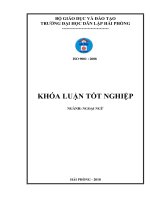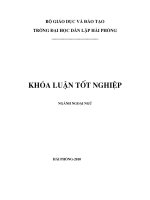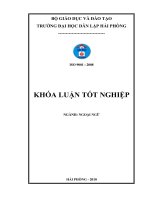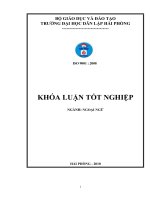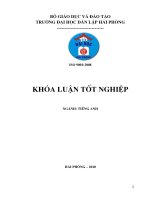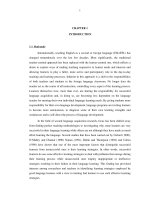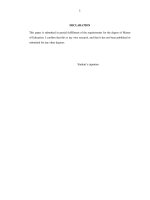A study on irony in short stories by edgar allan poe
Bạn đang xem bản rút gọn của tài liệu. Xem và tải ngay bản đầy đủ của tài liệu tại đây (488.81 KB, 13 trang )
VIETNAM NATIONAL UNIVERSITY, HANOI
UNIVERSITY OF LANGUAGES AND INTERNATIONAL STUDIES
FACULTY OF POST – GRADUATE STUDIES
**********************
LÊ THỊ HƢƠNG
A STUDY ON IRONY IN SHORT STORIES BY
EDGAR ALLAN POE
(Nghiên cứu tính mỉa mai trong các truyện ngắn của Edgar Allan Poe)
M. A. Minor Program Thesis
Field: English Linguistics
Code: 60220201
HA NOI – 2016
VIETNAM NATIONAL UNIVERSITY, HANOI
UNIVERSITY OF LANGUAGES AND INTERNATIONAL STUDIES
FACULTY OF POST – GRADUATE STUDIES
**********************
LÊ THỊ HƢƠNG
A STUDY ON IRONY IN SHORT STORIES BY
EDGAR ALLAN POE
(Nghiên cứu tính mỉa mai trong các truyện ngắn của Edgar Allan Poe)
M. A. Minor Program Thesis
Field: English Linguistics
Code: 60220201
Supervisor: Trần Thị Thu Hiền, Ph.D
HA NOI – 2016
DECLARATION
I hereby certify my authority of the research submitted entitled “A Study on Irony
in Short Stories by Edgar Allan Poe” in partial fulfillment of the requirements for
the degree of Master of Arts.
Hanoi, 2016
Lê Thị Hƣơng
i
ACKNOWLEDGEMENTS
Throughout accomplishing this thesis, namely “A Study on Irony in Short Stories
by Edgar Allan Poe”, several outstanding individuals are integrally involved and
make substantial contributions.
First of all, my deepest gratitude goes to all my lecturers at University of Languages
and International Studies, Vietnam National University, Hanoi, for their endless
enthusiasm and undeniable helpful lectures. I would be very grateful to the staff of
the Post-graduate Department for their support during the time of studying.
I especially would like to express my sincere gratitude to my supervisor Dr. Trần
Thị Thu Hiền for her invaluable guidance, insightful comments and endless support
of material. I would like to take this opportunity to thank Dr. Ngô Tự Lập for his
discerning comments, helpful advice and inestimable material support.
My thanks are extended to my friends, who gives me wise idea and always ready to
help me whenever I have difficulties. Last but not least, my warmest thanks are due
to my family, especially my mother for their unconditional love and continual
encouragement.
To all mentioned, and to many more, my heart extends the most enormous thanks.
Hanoi, 2016
Lê Thị Hƣơng
ii
ABSTRACT
The research aims at studying irony in Edgar Allan Poe‟s works represented in three
short stories - The Cask of Amontillado, The Tell- Tale Heart, and The Black Cat.
The theory of irony in literature suggested by Muecke (1969) is mainly adopted as
the analytical framework in this study. This research utilizes quantitative and
qualitative methods with priorities given to the qualitative. The data is collected by
means of reading, identifying, classifying and reporting them into the analysis. 31
samples of ironical expressions were found in Poe‟s three short stories, of which
there is one sample both verbal and dramatic ironies. The results show that verbal,
situational and dramatic ironies are mainly used in Poe‟s works. In addition, the
findings reveal that irony can be created by ten techniques in the art of irony
including pretended advice or encouragement to the victim, pretended agreement
with the victim, rhetorical question, innuendo and insinuation, ambiguity, false
statement, internal contradiction, fallacious reasoning, hyperbole and stylistically
signalled irony. This study hopes to bring additional knowledge to learners about
types of irony as well as a typical technique of creating irony in Edgar Allan Poe‟s
short stories in particular and an awareness of using and interpreting irony in
literary works in general.
iii
iv
PART A: INTRODUCTION
1.1. Rationale of the study
It is obvious that English has become an important part not only in
communication but also in many other aspects of life; therefore, mastering this
foreign language is of great importance. Learning English through literature works
is a good way. When learning literature works, we can not ignore to study stylistic
devices which
make works more intriguing and interesting. Similarily, when
learning stylistic devices, we can not pay no attention to studying irony. However,
how to study it well is still a difficult question for many learners.
Irony is an interesting language phenomenon used frequently in any spoken or
written genre. Simply, irony is a contrast between what is said and what is meant;
what is expected to happen and what actully happens; or what readers know and
what characters believe. Irony is a rhetorical device in literature which is often
employed to gain the desired effect of being scoffing, satirical, humorous and
amusing. Moreover, real life is full of ironical expressions and situations. Therefore,
the studying of irony in the literature works brings it closer to the life.
Edgar Allan Poe is one of the great American writers; he is also known as a master
of horror and irony who has the ability to use every word to his advantage, thus
creating a short story of great substance. In most of literary criticism dealing with
Edgar Allan Poe, little attention has been accorded to irony. In this sense, this title,
namely “A Study on Irony in Short Stories by Edgar Allan Poe” is conducted to
help learners understand irony concepts, identify and interpret types of irony in
Poe‟s short stories in particular and in literature works in general more easily.
1.2. Aims of the study
The study aims at:
(1) finding out common types of irony in Edgar Allan Poe‟s short stories;
(2) investigating the creation of irony in Edgar Allan Poe‟s short stories;
(3) suggesting the implications for teaching and learning irony in literature works.
1
1.3. Scope of the study
Edgar Allan Poe‟s short stories include tale of horror, detective story and science
fiction. As a whole, this paper does not expect to cover irony in all works of Poe.
Poe‟s tales of horror is paid the most attention because of being often written
ironically. Due to the limited time, the data of this paper will only be collected
from three out of Poe‟s typical tales of horror: The Cask of Amontillado, The TellTale Heart, and The Black Cat, three relatively short stories written between the
years 1843-1846. The selected stories are among Poe's masterpieces which
possesses the quintessential-features of the gothic tale: a haunted house, darkness,
terror, madness and death. They are translated into Vietnamese most among Poe‟s
short stories as of 2011 and served as teaching American and English literature at
some Vietnamese universities.
1.4. Significance of the study
Irony is an interesting rhetorical device in literature, thus a detailed and systematic
study on irony has both theoretical and practical significances. Firstly, the study is
expected to provide useful knowledge about types of irony as well as the creation of
irony in Poe‟s short stories. Secondly, the study helps Vietnamese learners of
English better understand and interpret irony in literary works. Moreover, it can
contribute to teaching American and English literature at Vietnamese
universities of foreign languages. Eventually, the study hopes to add to a new
approach to Poe‟s short stories, which creates more diversity in an research area on
Poe‟s short stories latterly.
1.5. Research methodology
1.5.1. Research questions
In order to cover all above aims, the study is to shed light on the following research
questions:
(1) What common types of irony are found in Edgar Allan Poe‟s short stories ?
(2) How is irony created in Edgar Allan Poe‟s short stories?
2
REFERENCES
Vietnamese
[1]. Đinh Trọng Lạc. (1994). 99 Phương tiện và biện pháp tu từ. NXB Giáo dục.
[2]. Hoàng Văn Quang. (1989). Truyện kinh dị Edgar Allan Poe (tập truyện ngắn).
Quảng Nam - Đà Nẵng: NXB Lao động.
[3]. Hoàng Kim Oanh. (2011). Sự Tiếp Nhận Edgar Allan Poe ở Việt Nam. Luật án tiến
sỹ ngữ văn. Viện hàn lâm khoa học xã hội Việt Nam. Học viện Khoa học Xã hội.
[4]. Ngô Bích Thu. (2014). Nghệ Thuật Xây Dựng Cốt Truyện Của Edgar Allan
Poe. Luật án tiến sỹ ngữ văn. Viện hàn lâm khoa học xã hội Việt Nam. Học viện
Khoa học Xã hội.
[5]. Khổng Đức. (2009). Edgar Allan Poe khát khao sáng tạo và huỷ diệt. Hà Nội:
NXB Thời đại.
[6]. Ngô Tự Lập. (2002). Tuyển tập Edgar Allan Poe. Hà Nội: NXB Văn học.
English
[7]. Abrams, M.H. (1999). A Glossary of Literary Terms, 7th ed. Boston:
Wadsworth.
[8]. Abrams, M.H. & Harpham, G.G. (2009). A Glossary of Literary Terms. 9th ed.
Boston: Wadsworth Cengage Learning.
[9]. Aliaga, M. & Gunderson, B. (2002). Interactive Statistics. New Jersey:
Prentice Hall.
[10]. Attardo, S., Grice, P., Sperber, D. & Wilson, D. (2009).
Concise
Encyclopedia of Pragmatics. Mey, L (ed.), Elsevier.
[11]. Attardo, S. (2001). Humorous Texts: A Semantic and Pragmatic Analysis.
Mouton de Gruyter.
[12]. Attardo, S. (2000). “Irony Makers and Functions: Towards a Goal-Oriented
Theory of Irony and its Processing”. Journal of RASK ,12, 3-20.
[13]. Austin, J.L. (1962). How to Do Things with Words. Clarendon, Oxford.
[14]. Barbe, K. (1995). Irony in Context. New York, NY: John Benjamins.
3
[15]. Berrendonner, A. (1981). Elements De Pragmatique Linguistique. Paris:
Minuit.
[16]. Booth, W. C. (1974). A Rhetoric of Irony. Chicago: The University of Chicago Press.
[17]. Clark, H.H. & Gerrig, R.J. (1984).
“On the Pretense Theory of Irony.”
Journal of Experimental Psychology: General, 113, 121-126.
[18]. Cohen, L., et al. (2007). Research Methods in Education. London and New
York: Routledge.
[19]. Colston, H.L. (1997). „I've Never Seen Anything like It: Overstatement,
Understatement, and Irony”. Metaphor and Symbol. Volume 12, Issue 1, 43-58.
[20]. Cuddon, J.A. (1977). A Dictionary of Literary Terms. Harmondsworth:
Penguin Books.
[21]. Dews, S., Kaplan, J., & Winner, E.(1995). “Why Not Say It Directly? The
Social Functions of Irony”. Discourse Processes.Volume 19, Issue 3.
[22]. Elleström, L. (2002). Divine Madness: On Interpreting Literature, Music and
the Visual Arts. Bucknell University Press.
[23]. Gibbs, R. W. & Colston, H. L. (2007). Irony in Language and Thought: A
Cognitive Science Reader. Lawrence Erlbaum Associates.
[24]. Grice, P. H. (1975). Logic and Conversation. Cambridge, MA: Harvard
University Press.
[25]. Jönsson, M. (2010). “Irony in Online Reviews: A linguistic approach to
identifying irony”. Advanced Undergraduate Level Research Essay. University of
Gothenburg.
[26]. Jorgensen, J., Miller, G. A. & Sperber, D. (1984). Test of the mention theory
of irony. Journal of Experimental Psychology: General, 113, 112–120.
[27]. Kalbermatten, M.I. (2006). Verbal Irony as a Prototype Category in Spanish: A
Discoursive Analysis. Unpublished Dissertation. University of Minnesota.
[28]. Kreuz, R. J., & Roberts, R. M. (1993). “On Satire and Parody: The Importance
of Being Ironic”. Metaphor and Symbolic Activity, Volume 8, Issue 2, 97-109.
4
[29]. Kreuz, R. J., & Roberts, R. M. (1995). “Two cues for verbal irony: Hyperbole and
Ironic Tone of Voice”. Metaphor and Symbolic Activity. Volume 10, Issue 1, 21-32.
[30]. Lemieux, M. (1991). The Evolution of Irony in the Short Stories of Chekhov.
Master thesis. McGiIl University.
[31].
Lüders,
J.
(2010).
“Stylistic
Devices”
retrieved
from:
/>[32]. Muecke, D. C. (1969). The Compass of Irony. London: Methuen.
[33]. Muecke, D.C. (1982). Irony and the Ironic. London and New York: Methuen.
[34]. Nunan, D. (1992). Research Methods in Language Learning. Cambridge
University Press.
[35]. Poe, E.A. (1984). Complete Stories and Poems of Edgar Allan Poe.
USA: Publisher.
[36]. Roman, B., Gassmann, O., Sabine, R., & Marco, Z. (2013). How do
qualitative and quantitative research differ? Switzerland: University of St.
Gallen.
[37]. Shively, R.L., Menke, M.R. & Manzón-Omundson, S.M. (2008). “Perception
of Irony by L2 Learners of Spanish”. Issues in Applied Linguistics. Volume 16, No.
2, 101-132. Regents of the University of California.
[38]. Sperber, D. & Wilson, D. (1986). Relevance: Communication and cognition.
Oxford: Blackwell.
[39]. 2011. Springboard. English Textual Power, Level 4. College Board.
[40]. Sova, D.B. (2007). Critical Companion to Edgar Allan Poe: A literary
reference to his life and work. Cristina Mandoiu
[41]. Thompson, A. R. (1948). The Dry Mock: A Study of Irony in Drama,
Berkeley: University of California Press.
[42]. Yoder, T.S. (2008). Hume on God: Irony, Deism and Genuine Theism.
Continuum International Publishing Group.
[43]. Yus Ramos, F. (2000). “On reaching the intended ironic interpretation.
International”. Journal of Communication, 10 (1-2), 27-78.
5
[44]. />[45]. />[46]. />[47]. />[48]. />[49]. />
6
I
